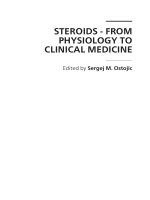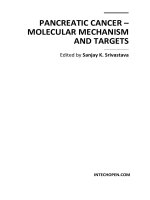Genetic Transformation Edited by María Alejandra Alvarez potx
Bạn đang xem bản rút gọn của tài liệu. Xem và tải ngay bản đầy đủ của tài liệu tại đây (16.48 MB, 340 trang )
GENETIC
TRANSFORMATION
Edited by María Alejandra Alvarez
Genetic Transformation
Edited by María Alejandra Alvarez
Published by InTech
Janeza Trdine 9, 51000 Rijeka, Croatia
Copyright © 2011 InTech
All chapters are Open Access articles distributed under the Creative Commons
Non Commercial Share Alike Attribution 3.0 license, which permits to copy,
distribute, transmit, and adapt the work in any medium, so long as the original
work is properly cited. After this work has been published by InTech, authors
have the right to republish it, in whole or part, in any publication of which they
are the author, and to make other personal use of the work. Any republication,
referencing or personal use of the work must explicitly identify the original source.
Statements and opinions expressed in the chapters are these of the individual contributors
and not necessarily those of the editors or publisher. No responsibility is accepted
for the accuracy of information contained in the published articles. The publisher
assumes no responsibility for any damage or injury to persons or property arising out
of the use of any materials, instructions, methods or ideas contained in the book.
Publishing Process Manager Dragana Manestar
Technical Editor Teodora Smiljanic
Cover Designer Jan Hyrat
Image Copyright Sashkin, 2011. Used under license from Shutterstock.com
First published August, 2011
Printed in Croatia
A free online edition of this book is available at www.intechopen.com
Additional hard copies can be obtained from
Genetic Transformation, Edited by María Alejandra Alvarez
p. cm.
ISBN 978-953-307-364-4
free online editions of InTech
Books and Journals can be found at
www.intechopen.com
Contents
Preface IX
Part 1 Agrobacterium: New Insights into a Natural Engineer 1
Chapter 1 Agrobacterium-Mediated Genetic Transformation:
History and Progress 3
Minliang Guo, Xiaowei Bian, Xiao Wu and Meixia Wu
Chapter 2 Structure-Function Analysis of Transformation Events 29
Yuri N. Zhuravlev and Vladik A. Avetisov
Part 2 Plant Transformation: Improving Quality of Fruits,
Crops and Trees - Molecular Farming 53
Chapter 3 Genetic Transformation in Tomato: Novel Tools
to Improve Fruit Quality and Pharmaceutical Production 55
Antonio Di Matteo, Maria Manuela Rigano,
Adriana Sacco, Luigi Frusciante and Amalia Barone
Chapter 4 Genetic Transformation Strategies in Fruit Crops 81
Humberto Prieto
Chapter 5 Citrus Transformation: Challenges and Prospects 101
Vicente Febres, Latanya Fisher, Abeer Khalaf and Gloria A. Moore
Chapter 6 Evaluation of Factors Affecting European Plum
(Prunus domestica L.) Genetic Transformation 123
Yuan Song, Fatih Ali Canli, Farida Meerja, Xinhua Wang,
Hugh A. L. Henry, Lizhe An and Lining Tian
Chapter 7 Genetic Transformation of Wheat:
Advances in the Transformation Method and Applications
for Obtaining Lines with Improved Bread-Making Quality
and Low Toxicity in Relation to Celiac Disease 135
Javier Gil-Humanes, Carmen Victoria Ozuna, Santiago Marín,
Elena León, Francisco Barro and Fernando Pistón
VI Contents
Chapter 8 Maize Transformation to Obtain Plants
Tolerant to Viruses by RNAi Technology 151
Newton Portilho Carneiro and Andréa Almeida Carneiro
Chapter 9 Genetic Transformation
of Triticeae Cereals for Molecular Farming 171
Goetz Hensel
Chapter 10 Genetic Transformation of Forest Trees 191
Osvaldo A. Castellanos-Hernández, Araceli Rodríguez-Sahagún,
Gustavo J. Acevedo-Hernández and Luis R. Herrera-Estrella
Chapter 11 Agrobacterium-Mediated Transformation
of Indonesian Orchids for Micropropagation 215
Endang Semiarti, Ari Indrianto, Aziz Purwantoro,
Yasunori Machida and Chiyoko Machida
Chapter 12 Transient Transformation of Red Algal Cells:
Breakthrough Toward Genetic Transformation
of Marine Crop Porphyra Species 241
Koji Mikami, Ryo Hirata, Megumu Takahashi,
Toshiki Uji and Naotsune Saga
Part 3 Plant Transformation
as a Tool for Regulating Secondary Metabolism 259
Chapter 13 Application of Agrobacterium Rol Genes
in Plant Biotechnology: A Natural Phenomenon
of Secondary Metabolism Regulation 261
Victor P Bulgakov, Yuri N Shkryl, Galina N Veremeichik,
Tatiana Y Gorpenchenko and Yuliya V Inyushkina
Chapter 14 Transformed Root Cultures of Solanum dulcamara L.:
A Model for Studying Production
of Secondary Metabolites 271
Amani M. Marzouk
,
Stanley G. Deans,
Robert J. Nash and
Alexander I. Gray
Chapter 15 Genetic Transformation
for Metabolic Engineering of Tropane Alkaloids 291
María Alejandra Alvarez and Patricia L. Marconi
Chapter 16 Transgenic Plants for Enhanced
Phytoremediation – Physiological Studies 305
Paulo Celso de Mello- Farias, Ana Lúcia Soares Chaves
and Claiton Leoneti Lencina
Preface
It has been more than twenty five years now since the first transformed plant was
reported. Plant transgenesis has evolved since those first attempts; the advances have
led to the elucidation of numerous aspects of plant biology, physiology, and
Agrobacterium biology. Even more spectacular is the impact of plant transformation
on crop improvement. To this date, transgenic crops represent a 10 % of the 1.5 billion
hectares of cropland worldwide, and constitute one of the main sources of incomes for
countries like the USA (66.8 million hectares), Brazil (25.4), Argentina (22.9), India
(9.4), Canada (8.8), China (3.5), Paraguay (2.6), Pakistan (2.4), South Africa (2.2) and
Uruguay with 1.1 million hectares. Also, plant transformation had influence on fruit
and forest improvement and the development of desirable traits for ornamental plant
breeders. Moreover, the significant advances made in the use of transformed plants for
the production of recombinant proteins and for the engineering of secondary
metabolism pathways have made a new easy-scalable and economical rendering
platform available to the pharmaceutical industry.
Chapters in this book represent selected examples of the advances that are currently
undergoing in this field. In the first section, the history and progress of Agrobacterium
utilization as a transformation vector is presented along with a chapter dedicated to
the analysis of the related events from a structure-functional analysis. Also the
physiological and molecular background of phytoremediation is analyzed.
In the second section, the subject of plant improvement is widely covered in the
chapters related to the amelioration of crops, fruits and flowers with a couple of
chapters dedicated to the last advances in molecular farming and RNAi technology.
Finally, in the last section the paramount contribution that plant transformation has
made on secondary metabolism is reviewed.
I would like to thank each of the authors for their great efforts in producing their
articles. I am sure the readers will appreciate the contribution each of the researchers
has made and will recognize the value of each chapter.
X Preface
Finally, I would like to thank the staff of the InTech Open Access Publisher for their
invaluable support along the process of publishing this book, particularly Ms. Dragana
Manestar and Ms. Natalia Reinic.
Dr. María Alejandra Alvarez
National Scientific and Technical Research Council (CONICET)
Buenos Aires
Argentina
Part 1
Agrobacterium:
New Insights into a Natural Engineer
1
Agrobacterium-Mediated Genetic
Transformation: History and Progress
Minliang Guo
*
, Xiaowei Bian, Xiao Wu and Meixia Wu
College of Bioscience and Biotechnology, Yangzhou University, Jiangsu,
P. R. China
1. Introduction
Agrobacterium tumefaciens is a Gram-negative soil phytopathogenic bacterium that causes the
crown gall disease of dicotyledonous plants, which is characterized by a tumorous
phenotype. It induces the tumor by transferring a segment of its Ti plasmid DNA
(transferred DNA, or T-DNA) into the host genome and genetically transforming the host.
One century has past after A. tumefaciens was firstly identified as the causal agent of crown
gall disease (Smith & Townsend, 1907). However, A. tumefaciens is still central to diverse
fields of biological and biotechnological research, ranging from its use in plant genetic
engineering to representing a model system for studies of a wide variety of biological
processes, including bacterial detection of host signaling chemicals, intercellular transfer of
macromolecules, importing of nucleoprotein into plant nuclei, and interbacterial chemical
signaling via autoinducer-type quorum sensing (McCullen & Binns, 2006; Newton & Fray,
2004; Pitzschke & Hirt, 2010). Therefore, the molecular mechanism underlying the genetic
transformation has been the focus of research for a wide spectrum of biologists, from
bacteriologists to molecular biologists to botanists.
1.1 History of Agrobacterium tumefaciens research
A. tumefaciens is capable of inducing tumors at wound sites of hundreds of dicotyledonous
plants, and some monocots and gymnosperms (De Cleene and De Ley, 1976), which may
happen on the stems, crowns and roots of the host. At the beginning of the last century,
crown gall disease was considered a major problem in horticultural production. This disease
caused significant loss of crop yield in many perennial horticultural crops (Kennedy, 1980),
such as cherry (Lopatin, 1939), apple (Ricker et al., 1959), and grape (Schroth et al., 1988). All
these horticultural crops are woody species and propagated by grafting scions onto
rootstocks. The grafting wounds are usually covered by soil and thus provide an excellent
infection point for the soil-borne A. tumefaciens. In 1941, it was proved that crown gall tumor
tissue could be permanently transformed by only transient exposure to the pathogen of A.
tumefaciens (White and Braun, 1941). Thereafter, a ‘tumor-inducing capacity’ was proposed
to be transmitted from A. tumefaciens to plant tissue (Braun, 1947; Braun and Mandle, 1948).
Twenty years late, molecular techniques provided the first evidence that crown gall tumors,
*
corresponding author:
Genetic Transformation
4
cultured axenically, contained DNA of A. tumefaciens origin, which implied that host cells
were genetically transformed by Agrobacterium (Schilperoort et al., 1967). In 1974, the tumor-
inducing (Ti) plasmid was identified to be essential for the crown gall-inducing ability (Van
Larebeke et al., 1974; Zaenen et al., 1974). Southern hybridization turned out to prove that
the bacterial DNA transferred to host cells originates from the Ti plasmid and ultimately
resulted in the discovery of T-DNA (transferred DNA), specific segments transferred from
A. tumefaciens to plant cells (Chilton et al., 1977; Chilton et al., 1978; Depicker et al., 1978).
The T-DNA is referred to as the T-region when located on the Ti-plasmid. The T-region is
delimited by 25-bp directly repeated sequences, which are called T-DNA border sequences.
The T-DNAs, when transferred to plant cells, encode enzymes for the synthesis of (1) the
plant hormones auxin and cytokinin and (2) strain-specific low molecular weight amino acid
and sugar phosphate derivatives called opines. The massive accumulation of auxin and
cytokinin in transformed plant cells causes uncontrolled cell proliferation and the synthesis
of nutritive opines that can be metabolized specifically by the infecting A. tumefaciens strain.
Thus, the opine-producing tumor effectively creates an ecological niche specifically suited to
the infecting A. tumefaciens strain (Escobar & Dandekar, 2003; Gelvin, 2003). Besides the T-
DNAs, Ti-plasmid also contains most of the genes that are required for the transfer of the T-
DNAs from A. tumefaciens to the plant cell.
Initial study of these plant tumors was intended to reveal the molecular mechanism that
may be relevant to animal neoplasia. Although no relationship was found between animal
and plant tumors, A. tumefaciens and plant tumor were proved to be of intrinsic interest
because the tumorous growth was shown to result from the transfer of T-DNA from
bacterial Ti-plasmid to the plant cell and the stable integration of the T-DNA to plant
genome. The demonstration that wild-type T-DNA coding region can be replaced by any
DNA sequence without any effect on its transfer from A. tumefaciens to the plant inspired the
promise that A. tumefaciens might be used as gene vector to deliver genetic material into
plants. In the early of 1980’s, two events about A. tumefaciens mediated genetic
transformation signaled the beginning of the era of plant genetic engineering. First, A.
tumefaciens and its Ti-plasmid were used as a gene vector system to produce the first
transgenic plant (Zambryski et al., 1983). The healthy transgenic plants had the ability to
transmit the disarmed T-DNA, including the foreign genes, to their progeny. Second, non-
plant antibiotic-resistance genes, for example, a bacterial kanamycin-resistance gene, could
be instructed to function efficiently in plant cells by splicing a plant-active promoter to the
coding region of the bacterial genes. This enabled accurate selection of transformed plant
cells (Beven, 1984). The eventual success of using A. tumefaciens as a gene vector to create
transgenic plants was viewed as a prospect and a “wish”. The future of A. tumefaciens as a
gene vector for crop improvement began to look bright. During the 1990’s, maize, a monocot
plant species that was thought to be outside the A. tumefaciens “normal host range”, was
successfully transformed by A. tumefaciens (Chilton, 1993). Today, many agronomically and
horticulturally important plant species are routinely transformed by A. tumefaciens, and the
list of plant species that can be genetically transformed by A. tumefaciens seems to grow
daily (Gelvin
, 2003). At present, many economically important crops, such as corn, soybean,
cotton, canola, potatoes, and tomatoes, were improved by A. tumefaciens–mediated genetic
transformation and these transgenic varieties are growing worldwide (Valentine, 2003). By
now, the species that are susceptible to A. tumefaciens–mediated transformation were
broadened to yeast, fungi, and mammalian cells (Lacroix et al., 2006b).
Agrobacterium-Mediated Genetic Transformation: History and Progress
5
In the new century, intrests of most Agrobacterium community shifted to the transfer channel
and host. Most recent important articles on Agrobacterium-mediated T-DNA transfer are to
explore the molecular mechanism of T-complex targeting to plant nucleus. Recent
progresses of these aspects of Agrobacterium-mediated genetic transformation will be the
emphases of this chapter and be discussed in the following related sections.
1.2 Basic process of A. tumefaciens–mediated genetic transformation
The process of A. tumefaciens–mediated genetic transformation is a long journey. For the
sake of description, many authors divided this process into several steps (Guo et al., 2009a;
Guo, 2010; McCullen & Binns, 2006; Pitzschke & Hirt, 2010). Here, we arbitrarily and simply
split it into five steps: (1) Sensing of plant chemical signals and inducing of virulence (vir)
proteins. The chemical signals released by wounded plant are perceived by a VirA/VirG
two-component system of A. tumefaciens, which leads to the transcription of virulence (vir)
gene promoters and thus the expression of vir proteins. (2) T-DNA processing. T-DNA is
nicked by VirD2/VirD1 from the T-region of Ti plasmid and forms a single-stranded linear
T-strand with one VirD2 molecule covalently attached to the 5′end of the T-strand. (3)
Attaching of A. tumefaciens to plant and transferring of T-complex to plant cell. A. tumefaciens
cell attaches to plant and transfers the T-complex from A. tumefaciens to plant cell by a
VirD4/B T4SS transport system. (4) Targeting of T-complex to plant cell nucleus and
integrating of T-DNA into plant genome. The T-complex is transported into the
nucleoplasm under the assistance of some host proteins and then integrated into plant
genomic DNA. (5) Expressing of T-DNA in plant cell and inducing of plant tumor. The T-
DNA genes encode phytohormone synthases that lead to the uncontrolled proliferation of
plant cell and opine synthases that provide nutritive compounds to infecting bacteria.
2. Events happening in Agrobacteriun
A. tumefaciens can perceive the signal molecules from plants and recognize the competent
hosts. To fulfill the infection, Agrobacterium must respond to the signal molecules. The
respondence occuring in Agrobacterium includes host recognition, virulence gene expression,
and T-DNA processing.
2.1 Sensing of plant signal molecules and vir gene induction
Many genes are involved in A. tumefaciens-mediated T-DNA transfer, but most of the genes
required for T-DNA transfer are found on the vir region of Ti plasmid. This vir region
comprises at least six essential operons (virA, virB, virC, virD, virE, and virG,) and two non-
essential operons (virF and virH) encoding approximate 25 proteins (Gelvin, 2000; Zhu et al.,
2000; Ziemienowicz, 2001). These proteins are termed virulence (vir) proteins and required
for the sensing of plant signal molecules as well as the processing, transfer, and nuclear
localization of T-DNA, and the integration of T-DNA into the plant genome. The protein
number encoded by each operon differs; virA, virG and virF encode only one protein; virE,
virC, and virH encode two proteins; virD encodes four proteins and virB encodes eleven
proteins. Only virA and virG are constitutively transcripted. The transcription of all other vir
operons in vir region is coordinately induced during infection by a family of host-released
phenolic compounds in combination with some monosaccharides and extracellular acidity
in the range of pH 5.0 to 5.8. Virtually all of the genes in the vir region are tightly regulated
by two proteins VirA and VirG encoded by virA operon and virG operon (Lin et al., 2008).
Genetic Transformation
6
The inducible expression of vir operons was first found by using the cocultivation of A.
tumerfaciens with mesophyll protoplasts, isolated plant cells or cultured tissues (Stachel et
al., 1986). In vegetatively growing bacteria, only virA and virG are expressed at significant
level. However, when Agrobacteria are cocultivated with the susceptible plant cells, the
expression of virB, virC, virD, virE and virG are induced to high levels (Engstrom et al.,
1987). The partially purified extracts of conditioned media from root cultures can also
induce the expression of vir operons, demonstrating that the vir-inducing factors are some
diffusible plant cell metabolites. By screening 40 plant-derived chemicals, Bolton et al. (1986)
identified seven simple plant phenolic compounds that possess the vir-inducing activity.
Most of these vir-inducing phenolic compounds are needed to make lignin, a plant cell wall
polymer. The best characterized and most effective vir gene inducers are acetosyringone
(AS) and hydroxy-acetosyringone from tobacco cells or roots (Stachel et al., 1985). The
specific composition of phenolic compounds secreted by wounded plants is thought to
underlie the host specificity of some Agrobacterium strains. Besides phenolic compounds,
other inducing factors include aldose monosaccharides, low pH, and low phosphate
(Brencic & Winans, 2005; McCullen & Binns, 2006; Palmer et al., 2004). However, phenols are
indispensable for vir gene induction, whereas the other inducing factors sensitise
Agrobacteria to phenols.
2.2 Regulation of vir gene induction
The regulatory pathway for vir gene induction by phenolic compounds is mediated by the
VirA/VirG two-component system, which has structural and functional similarities to other
already described for other cellular regulation mechanisms (Bourret et al., 1991; Nixon et al.,
1986). Two component regulatory systems comprise two core components, a sensor kinase
and an intracellular response regulator. The sensor kinase responds to signal input and
mediates the activation of the intracellular response regulator by controlling the latter’s
phoshporylation status (Brencic & Winans, 2005; McCullen & Binns, 2006). For the
Agrobacterium VirA/VirG two-component system, VirA is a membrane-bound sensor
kinase. The presence of acidic environment and phenolic compounds at a plant wound site
may directly or indirectly induce autophosphorylation of VirA. The phosphorylated VirA
can transfer its phosphate to the cytoplasmic VirG to activate VirG. The activated VirG
binds to the specific 12bp DNA sequences called vir box enhancer elements that are found in
the promoters of the virA, virB, virC,
virD, vi
rE and virG operons, and then upregulates the
transcription of these operons (Winans, 1992).
Octopine-type Ti plasmid encoded VirA protein has 829 amino acids. VirA is a member of the
histidine protein kinase class and able to autophosphorylate. When VirA autophosphorylates
in vitro, the phosphate was found to bind to histidine residue 474, a histidine residue that is
absolutely conserved among homologous proteins (Jin et al., 1990). VirA protein can be
structurally divided into a number of domains. In an order from N-terminus to C-terminus,
these domains are defined as transmembrane domain 1 (TM1), periplasmic domain,
transmembrane domain 2 (TM2), linker domain, kinase domain and receiver domain (Lee et
al., 1996). The periplasmic domain is required for the interaction with ChvE, the sugar-binding
protein that responds to the vir-inducing sugars. The linker domain is located on the region of
amino acid 280~414, which was supposed to interact with the vir gene inducing phenolic
compounds (Chang & Winans 1992). A highly amphipathic helix sequence of 11 amino acids
was identified in the region of amino acid 278-288. This amphipathic sequence is highly
Agrobacterium-Mediated Genetic Transformation: History and Progress
7
conserved in a large number of chemoreceptor proteins and thus was supposed to be the
receptor site for phenolic inducers (Turk et al., 1994). However, it is unclear whether the
phenolic inducers interact with VirA directly or indirectly. The kinase domain is a highly
conserved domain that presents in the family of the sensor proteins and contains the
conserved histidine residue 474 that is the autophosphorylation site. Site-directing mutation of
this His 474 results in avirulence and the lost of vir gene inducing expression in the presence of
plant signal molecules (Jin et al., 1990). The receiver domain shows an unusual feature that is
homologous to a region of VirG. Similar receiver domains are present in a small number of
homologous histidine protein kinases, but the function of this domain is unclear.
VirG is a transcriptional activator of 241 amino acid residues. It is composed of two main
domains, N-terminal domain and C-terminal domain. The aspartic acid 52 in the N-terminal
domain of VirG can be phosphorylated by the phosphorylated VirA (Jin et al, 1993). The
phosphorylation of N-terminal domain is thought to induce the conformation change of C-
terminal domain. The C-terminal domain of VirG possesses the DNA-binding function,
resulting in VirG specifically binding to the vir box sequence that is found within 80
nucleotides upstream from the transcription initiation sites of vir genes. Phosphorylation is
required for the transcriptional activation function of VirG, but how phosphorylation
modulates the properties of VirG is unknown. Some models suggested that phosphorylation
might increase the affinity of VirG to its binding sites or promote the ability of VirG to
contact RNA polymerase (Lin et al., 2008; McCullen & Binns, 2006; Wang et al., 2002).
2.3 T-DNA processing
The activation of vir genes initiates a cascade of events. Following the expression of vir
genes, some Vir proteins produce the transfer intermediate, a linear single stranded (ss)
DNA called T-DNA or T-strand that is derived from the bottom (coding) strand of the T-
region of the Ti plasmid. T-region is flanked by two 25 bp long imperfect direct repeats,
termed border sequences. VirD2/VirD1 is able to recognize the border sequences and cleave
the bottom strand of T-region at identical positions between bp 3 and 4 from the left end of
each border (Sheng & Citovsky, 1996). Upon the cleavage of T-DNA border sequence, VirD2
remains covalently associated with the 5´-end of the ssT-strand via tyrosine residue 29
(Vogel & Das, 1992). The excised ssT-strand is removed, and the resulting single-stranded
gap in the T-region is repaired, most likely replaced by a newly synthesizing DNA strand.
The association of VirD2 with the 5´-end of the ssT-strand is believed to prevent the
exonucleolytic attack to the 5´-end of the ssT-strand (Durrenberger et al., 1989) and to
distinguish the 5´-end as the leading end of the T-DNA complex during transfer.
One report indicated that VirD1 possesses a topoisomerase-like activity (Ghai and Das,
1989). VirD1 appears to be a type I DNA topoisomerase that do not require ATP for activity.
However, a late study (Scheiffele et al., 1995) contradicted this conclusion. The VirD1
protein purified by Scheiffele et al. (1995) never showed any topoisomerase activity. It was
speculated that the topoisomerase activity observed by Ghai and Das (1989) might originate
from VirD2. Mutational study of VirD1 showed that a region from amino acids 45~60 is
important for VirD1 activity. Sequence comparison of this fragment with the functionally
analogous proteins of conjugatable bacterial plasmids showed that this region is a potential
DNA-binding domain (Vogel & Das, 1994).
The nopaline Ti plasmid encoded VirD2 consists of 447 amino acids with a molecular weight
of 49.7 kDa. Deletion analysis of VirD2 demonstrated that the C-terminal 50% of VirD2
could be deleted or replaced without affecting its endonuclease activity. Sequence
Genetic Transformation
8
comparison of VirD2 from different Agrobacterium species shows that the N-terminus is
highly conserved with 90% homology, whereas only 26% homology is found in the C-
terminus (Wang et al., 1990). A sequence comparison of VirD2 protein with its functionally
homologous proteins in bacterial conjugation and in rolling circle replication revealed that a
conserved 14-residue motif lies in the residues 126~139 of VirD2. This motif contains the
consensus sequence HxDxD(H/N)uHuHuuuN (invariant residues in capital letters; x, any
amino acid; u, hydrophobic residue) (Ilyina & Koonin, 1992). Mutational analysis indicated
that all the invariant residues except for the last asparagine (N) in this motif are important
for the endonuclease activity of VirD2. The second aspartic acid (D) and three nonconserved
residues in this motif are also essential for the endonuclease activity of VirD2 (Vogel et al.,
1995). This motif is believed to coordinate the essential cofactor Mg
2+
by the two histidines
in the hydrophobic region of the motif (Ilyina & Koonin, 1992). The poorly conserved C-
terminal halves of VirD2 from different Agrobacterium species displayed a very similar
hydropathy profile (Wang et al., 1990). The C-terminal domain of VirD2 is thought to guide
the T-complex to the plant nucleus. The sequence characterization and function of this
region of VirD2 will be discussed in a late section of this chapter.
3. Contact of Agrobacterium with plant and transfer of Agrobacterial
molecules to plant
3.1 Chemotaxis of A. tumefaciens
A. tumefaciens is a motile organism, with peritrichous flagellae, that possesses a highly
sensitive chemotaxis system. It could respond to a range of sugars and amino acids and be
attracted to these sugars and amino acids (Loake et al., 1988). A. tumefaciens mutants
deficient in motility and in chemotaxis were fully virulent when inoculated directly.
However, when used to inoculate soil, which was air-dried and then used to grow plants,
these mutants were completely avirulent. These results indicated that the motility and
chemotaxis are critical to A. tumefaciens infection under natural conditions (Hawes & Smith,
1989). Wild-type A. tumefaciens strains both containing and lacking Ti plasmid exhibited
chemotaxis toward excised root tips from all plant species tested and toward root cap cells
of pea and maize, suggesting that the majority of chemotactic responses in A. tumefaciens
appear to be chromosomally encoded (Loake et al., 1988; Parke et al., 1987). However, the
chemotactic response to some phenolic compounds, for example acetosyringone, which
were identified as strong vir gene inducers, is controversial. Some reports showed that
chemotaxis toward acetosyringone requires the presence of a Ti plasmid, specifically the
regulatory genes virA and virG, and occurs with a threshold sensitivity of < 10
-8
M, some
1000-fold below the maximal vir-inducing concentration (Ashby et al., 1988; Shaw et al.,
1989). Whereas, reports from other groups indicated that acetosyringone did not elicit
chemotaxis at any concentration (Hawes & Smith, 1989) and chemotaxis toward related
compounds did not require the Ti plasmid (Park et al., 1987). So, it does seem difficult to
rationalize a role for acetosyringone and the regulatory genes virA and virG in
chemotaxis.
3.2 Attachment of A. tumefaciens to plant
It is reasonable that an intimate association between pathogen and host cells is required for
the transfer of T-DNA and virulence proteins from A. tumefaciens to plant cells. A.
tumefaciens can efficiently attach to both plant tissues and abiotic surfaces, and establish
Agrobacterium-Mediated Genetic Transformation: History and Progress
9
complex biofilms at colonization sites. Microscopic observation of bacteria interacting with
the plant cells demonstrates a significant propensity to attach in a polar fashion (Smith &
Hindley, 1978; Tomlinson & Fuqua, 2009). All Agrobacterium mutants deficient in attachment
to plant cells are either avirulent or extremely attenuated in virulence (Cangelosi et al., 1989;
Douglas et al., 1982, 1985; Matthysse & McMahan, 2001; O’Connell & Handelsman, 1989).
Although obviously critical, the attachment process is one of the least-characterized sets of
cellular processes in the entire interaction. Little progress on this area was made in recent
years (Tomlinson & Fuqua, 2009).
3.2.1 Bacterial genes involved in the attachment of A. tumefaciens to plant
The binding of A. tumefaciens to host plant cells seems to require the participation of specific
receptors that may exist on the bacterial and plant cell surface because the binding of A.
tumefaciens to host plant cells is saturable and unrelated bacteria fail to inhibit the binding of
A. tumefaciens to host plant cells (B.B. Lippincot & J.A. Lippincot, 1969). A number of A.
tumefaciens mutants reported to affect the attachment of bacteria to plant cells have been
isolated. Some related genes are identified and sequenced (Matthysse et al., 2000; Reuhs et
al., 1997). However, it is surprising that a large number of genes are involved in the bacterial
attachment to host cells and the actual functions of most genes are unclear (Matthysse et al.,
2000). All the genes reported to affect the bacterial attachment to host cells are chromosomal
genes.The genes involved in the binding of bacteria to host plant cells are identified to
mainly locate on two regions of the bacterial chromosome.
The binding of bacteria to host cells is thought to be a two-step process (Matthysse &
McMahan, 1998). The binding in the first step is loose and reversible because the bound
bacteria are easy to being washed from the binding sites by shear forces, such as water
washing or vortexing of tissue culture cells. Genes involved in this step are identified to
locate on the att gene region (more than 20 kb in size) of the bacterial chromosome. Gene
mutations in this region abolish virulence. The mutants in the att gene region can be divided
into two groups. The first group can be restored to attachment and virulence by the addition
of conditioned medium. This group appears to be altered in signal exchange between the
bacterium and the host. Mutations in this group of mutants occur in the genes homologous
to ABC transporters and transcriptional regulator as well as some closely linked
downstream genes (Matthysse et al., 2000; Matthysse & McMahan, 1998; Reuhs et al., 1997).
The second group of mutants in the att gene region is not affected by the presence of
conditioned medium. This mutant group appears to affect the synthesis of surface
molecules, which may play a role in the bacterial attachment to the host. This group
includes mutants in the genes homologous to transcriptional regulator and ATPase as well
as a number of biosynthetic genes, which include the transacetylase required for the
formation of an acetylated capsular polysaccharide. The acetylated capsular polysaccharide
is required for the bacterial attachment to some plants because the production of the
acetylated capsular polysaccharide is correlated to the attachment of wild-type strain C58 to
the host cells and the purified acetylated capsular polysaccharide from wild-type strains
blocks the binding of the bacteria to some host cells (Matthysse et al., 2000; Matthysse &
McMahan, 1998, 2001; Reuhs et al., 1997).
The second step in the bacterial attachment to the host results in tight binding of the
bacteria to the plant cell surface because the bound bacteria can no longer be removed
Genetic Transformation
10
from the plant cell surface by shear forces. This step requires the synthesis of cellulose
fibrils by the bacteria, which recruits larger numbers of bacteria to the wound sites.
Cellulose-minus bacterial mutants show reduced virulence (Minnemeyer et al., 1991). The
genes required for the synthesis of bacterial cellulose fibrils (cel genes) are identified to
locate on the bacterial chromosome near, but not contiguous with the att gene region
(Robertson et al., 1988).
Some other chromosomal virulence genes chvA, chvB, and pscA (exoC) are believed to be
involved indirectly in bacterial attachment to host (Cangelosi et al., 1987; Douglas et al.,
1982; O’Connell & Handelsman, 1989). These genes are involved in the synthesis,
processing, and export of a cyclic β-1,2-glucan, which has been implicated in the bacterial
binding to plant cells. Mutations in chvA, chvB, and pscA (exoC) cause a 10-fold decrease in
binding of bacteria to zinnea mesophyll cells and strongly attenuate virulence (Douglas et
al., 1985; Kamoun et al., 1989; Thomashow et al., 1987). ChvB is believed to be involved in
the synthesis of the cyclic β-1,2-glucan (Zorreguieta & Ugalde, 1986). ChvA is homologous
to a family of membrane-bound ATPases and appears to be involved in the export of the
cyclic β-1,2-glucan from the cytoplasm to the periplasm and extracellular fluid (Cangelosi et
al., 1989; De Iannino & Ugalde, 1989). However, the virulence of chvB mutants is
temperature sensitive (Banta et al., 1998). At lower temperature (16 ºC), chvB mutants
became virulent and were able to attach to plant roots (Bash & Matthysse, 2002).
3.2.2 Plant factors involved in the attachment of A. tumefaciens to plant
In addition to bacterial factors, some plant factors are essential for the attachment of A.
tumefaciens to plant cells. Two plant cell wall proteins: a vitronectin-like protein (Wagner &
Matthysse, 1992) and a rhicadhesin-binding protein (Swart et al., 1994) have been proposed
to mediate the bacterial attachment to plant cells. Vitronectin is an animal receptor that is
specifically utilized by different pathogenic bacteria (Burridge et al., 1988). A plant
vitronectin-like protein is reported to occur in several A. tumefaciens host plant (Sanders et
al., 1991). Human vitronectin and antivitronectin antibodies were shown to inhibit the
binding of A. tumefaciens to plant tissues. Nonattaching A. tumefaciens mutants, such as chvB,
pscA and att mutants, showed a reduction in the ability to bind vitronectin. Therefore, the
plant vitronectin-like protein was proposed to play a role in A. tumefaciens attachment to its
host cells (Wagner & Matthysse, 1992). However, a recent report argues against the role of
the vitronectinlike protein in bacterial attachment and Agrobacterium-mediated
transformation (Clauce-Coupel et al., 2008).
Genetic studies showed that additional plant cell-su
rface proteins might play a role in A.
tumefaciens attachment. Two Arabidopsis ecotypes, B1-1 and Petergof, which are highly
recalcitrant to Agrobacterium-mediated transformation, were proposed to be blocked at an
early step of the binding (Nam et al., 1997). Two Arabidopsis T-DNA insertion mutants of the
ecotype Ws, rat1 and rat3, which are resistant to Agrobacterium transformation (rat mutants),
are deficient in A. tumefaciens binding to cut root surfaces (Nam et al., 1999). DNA sequence
analysis indicated that rat1 and rat3 mutations affect an arabinogalactan protein (AGP) and
a potential cell-wall protein, respectively. AGPs were confirmed to be involved in A.
tumefaciens transformation (Nam et al., 1999). Interestingly, AGP17 (rat1 mutant) appears to
be involved in host defense reactions and signaling (Gaspar et al., 2004; Gelvin, 2010a).
Other two rat mutans, ratT8 and ratT9, were identified to be mutated in the genes coding for
receptor-like protein kinases (Zhu et al., 2003).
Agrobacterium-Mediated Genetic Transformation: History and Progress
11
3.3 Transfer of Agrobacterial molecules to plant
Following the production of T-DNA and attachment to the host cells, Agrobacterium
transports T-DNA and virulence proteins into the host. The transportation must cross the
bacterial cell membrane and wall, as well as host cell membrane and wall.
3.3.1 Transfer apparatus
A. tumefaciens uses type IV secretion system (T4SS) to transfer T-DNA and effector proteins
to its host cells (Cascales & Christie, 2003, 2004). The T4SS was initially defined to be a class
of DNA transporters whose components are highly homologous to the conjugal transfer
(tra) system of the conjugative IncN plasmid pKM101 and the A. tumefaciens T-DNA transfer
system (Burns, 2003; Christie & Vogel, 2000). T4SS, also known as the mating pair formation
(Mpf) apparatus, is a cell envelope-spanning complex (composed of 11-13 core proteins) that
is believed to form a pore or channel through which DNA and/or protein is delivered from
the donor cell to the recipient cell. Recently the members of T4SS have steady increased,
with the identification of additional systems involved in DNA and protein translocation
(Alvarez-Martinez & Christie, 2009; Cascales & Christie, 2003; Christie & Vogel, 2000;
Gillespie, 2010). However, the best-studied T4SS member is the VirB/D4 transporter of A.
tumefaciens. In the past decade, much of the research on Agrobacterium-mediated T-DNA
transfer focused on the vir-specific T4SS, the T-complex transporter. Therefore, the A.
tumefaciens T-complex transporter has become a paradigm of T4SS (Alvarez-Martinez &
Christie, 2009; Cascales & Christie, 2003).
The VirB/D4 T4SS is assembled from 11 proteins (VirB1 to VirB11) encoded by the virB
operon, and VirD4. At least 10 of the 11 VirB proteins are believed to be the structural
subunits of the T-pilin and associated transport apparatus that spans from the cytoplasm of
the cell, through the inner membrane, periplasmic space and outer membrane, to the outside
of the cell. In the past few years, work in identifying the interactions among the VirB protein
subunits and defining the steps in the transporter assembly pathway has extended our
knowledge of the structure of the VirB transport apparatus. To demonstrate the architecture
of the VirB/D4 transporter, a model that depicts the subcellular locations and interactions of
the VirB and VirD4 subunits of the A. tumefaciens VirB/D4 T4SS was proposed (Alvarez-
Martinez & Christie, 2009; Cascales & Christie, 2004). Recently, VirB7, VirB9, and VirB10
homologs from the pKM101 T4SS were purified and the cryoEM structure of a core complex
composed of pKM101 VirB7-like TraN, VirB9-like TraO, and VirB10-like TraF was revealed
(Fronzes et al., 2009).
Agrobacterium-mediated T-DNA transfer to plant shows striking similarities to the plasmid
interbacterial conjugation (Ream, 1989; Stachel & Zambryski, 1986). Bacterial conjugation
can be visualized as the merging of two ancient bacterial systems: the DNA rolling-circle
replication system and type IV secretion system (T4SS) (Llosa et al., 2002). The DNA rolling-
circle replication system in plasmid conjugation was also known as the DNA transfer and
replication (Dtr) system. The Dtr system corresponds to the T-DNA relaxase nucleoprotein
complex. The T4SS responding for the plasmid conjugation was initially called mating pair
formation (Mpf) system. In order to recognize these two systems and link them, a protein is
normally required for many conjugal plasmids to couple the Dtr to the Mpf. This protein
was called coupling protein as its function (Gomis-Ruth et al., 2002).
VirD4 is a homologue of coupling protein family and is believed to be the coupling protein
that links the transferred molecules and T4SS transporter. VirD4 is an inner membrane
Genetic Transformation
12
protein with potential DNA binding ability and ATPase activity. Membrane topology
analysis of VirD4 revealed that VirD4 contains an N-terminal-proximal region, which
includes two transmembrane helices and a small periplasmic domain, and a large C-
terminal cytoplasmic domain (Cascales & Christie, 2003; Das & Xie, 1998). VirD4 localizes to
the cell pole. The polar location of VirD4 was not dependent on T-DNA processing, the
assembly of T4SS transporter and the expression of other Vir proteins. Both the small
periplasmic domain and the cytoplasmic nucleotide-binding domain are required for the
polar localization of VirD4 and essential for T-DNA transfer. VirD4 forms a large oligomeric
complex (Kumar & Das, 2002). VirD4 can recruit VirE2 to the cell poles (Atmakuri et al.,
2003) and weakly interact with VirD2-T-strand complex (Cascales & Christie, 2004).
Although VirD4 is essential for coordinating the T4SS to drive T-DNA transfer, it has been
unclear whether VirD4 physically/directly interacts with the T4SS transporter. However,
the interaction between VirD4 homologues and the protein components of Dtr system
exhibits specificity. It was supposed that VirD4 protein might recruit T-complex to the T4SS
transporter through contacts with the T-complex protein and then through the contacts with
VirB10 coordinate the passage of T-complex through the T4SS channel (Cascales & Christie,
2003; Llosa et al., 2003). However, it should be pointed out that the recruitment of T-
complex might be much more difficult than the recruitment of single VirE2 molecule due to
the difference of molecular size between T-complex and VirE2. Recently, two cytoplasmic
proteins, VBP (VirD2-binding protein) (Guo et al., 2007a, 2007b) and VirC1 (Atmakuri et al.,
2007) were reported to be involved in the recruitment of the T-complex to T4SS. Genome-
wide sequence analysis showed that A. tumefaciens contains three vbp homologous genes.
Reverse genetic study showed that mutatons of three vbp genes highly attenuated the
bacterial ability to cause tumors on plants (Guo et al., 2007a, 2009b).
3.3.2 Agrobacterial molecules transported to plant
Agrobacterial molecules transported into host cells by VirB/D4 T4SS include the VirD2-T-
strand complex, VirE2, VirE3, VirF, and VirD5. VirD2 is covalently bound to the 5′end of
the T-strand. The bound VirD2, probably in conjunction with other protein components,
such as VBP (Guo et al., 2007a, 2007b) and VirC1 (Atmakuri et al., 2007), confers
recognition of the VirD2-T-strand complex by the VirB/D4 T4SS. VirD2 also “pilots” the
T-strand through the translocation channel. It was supposed that the VirB/D4 T4SS is
actually a protein transporter and the T-strand is the “hitchhiker” (Cascales & Christie,
2004).
VirE2 is a single-stranded DNA-binding protein (Christie et al., 1988; Citovsky et al., 1988)
that can bind single-stranded DNA without sequence specificity, and is supposed to protect
the T-strand from the nucleolytic degradation because single-stranded T-DNA is believed to
be susceptible to nucleases. The binding of VirE2 to single-stranded DNA is strong and co-
operative, suggesting that VirE2 coats the T-strand along its length (Citovsky et al., 1989).
Another possible function of VirE2 is to guide the nuclear import of T-DNA (Ziemienowicz
et al., 1999, 2001). This will be discussed in the following section of this chapter. Induced
Agrobacterium cell can produce sufficient VirE2 to bind all intracellular single-stranded T-
DNA. When bound to single-stranded DNA, VirE2 can alter the ssDNA from a random-coil
conformation to a telephone cord-like coiled structure and increases the relative rigidity
(Citovsky et al., 1997). Initial hypothesis is that the protective role of VirE2 is required to
function in both bacteria and plant cells. So, the prevailing view on the T-DNA transfer is
that a packaged nucleoprotein complex, the T-complex, composed of the T-strand DNA
Agrobacterium-Mediated Genetic Transformation: History and Progress
13
containing the 5´-associated VirD2 and coated with VirE2 along its length, is the transfer
intermediate (Howard & Citovsky, 1990; Zupan & Zambryski, 1997). This T-complex
structure model implies that both VirD2 and VirE2 together with the T-strand are
transported into plant cell in the same time. This idea makes biological sense because it is
likely that VirE2 with a high affinity to ssDNA may form a complex with the T-strand
already inside Agrobacterium cell, especially if both VirE2 and the T-strand are transported
through the same channel (Binns et al., 1995). Indeed, the T-complex, which contains T-
strand, VirD2 and VirE2, was observed in the crude extracts from vir-induced Agrobacterium
by using anti-VirE2 antibodies to co-immunoprecipitate both T-strand and VirE2 (Christie et
al., 1988).
However, two kinds of evidence argued against that the protective role of VirE2 is required
to function inside bacterial cells. The first is the observation that a strain expressing virE2
but lacking T-DNA can complement a virE2 mutant in a tumor formation assay (Otten et al.,
1984) and the T-strand accumulates to wild-type levels in virE2 mutants (Stachel et al., 1987;
Veluthambi et al., 1988). The second kind of evidence is that virE2 expression in transgenic
tobacco plants restores the infectivity of a VirE2-deficient Agrobacterium strain (Citovsky et
al., 1992). In addition, the observation that virE2 mutants can transfer T-DNA into plant cells
(Yusibov et al., 1994) also proved that VirE2 is not essential for the export of T-DNA. All
these data appear to support that T-DNA may not be packaged by VirE2 in the bacterial
cells, at least, the packaging of T-DNA inside bacterial cells by VirE2 is not necessary for the
tumor formation. VirE2 can be transported independently, but the transportation of VirE2
requires the activities of VirE1. VirE1 is a chaperone and is necessary for VirE2 translation
and stability but not essential for the recognition of the translocation signal of ViE2 by the
transport machinery and the subsequent translocation of VirE2 into plant cells, indicating
that the role of VirE1 playing in the export process of VirE2 seems restricted to the
stabilization of VirE2 by preventing VirE2 from the premature interactions in the bacterial
cell before translocation into plant cells (Vergunst et al., 2003).
Like VirD2 and VirE2, agrobacterial protein VirF can also be exported to plant cell (Vergunst
et al., 2000). virF gene is found only in the octopine-specific Ti plasmid. It is not essential for
T-DNA transfer. Initially, VirF is thought to be a host-range factor of Agrobacterium
(Regensburg-Tuink & Hooykaas, 1993). A more recent report showed that VirF interacts
with an Arabidopsis Skp1 protein (Schrammeijer et al., 2001). Yeast Skp1 protein and its
animal and plant homologs are subunits of the complexes involved in targeted proteolysis.
This targeted proteolysis can regulate the plant cell cycle. So, it was suggested that VirF may
function in setting the plant cell cycle to effect better transformation (Gelvin, 2003; Tzfira &
Citovsky, 2002).
Protein truncation and fusion of T4SS substrates demonstrated that certain C-terminal
motifs were required for the export of targeted substrates. The C-terminal 37 amino acids
of VirF and the C-terminal 50 amino acids of VirE2 and VirE3 are sufficient to mediate
transport of these fusion proteins to plants (Vergunst et al., 2000, 2003). The minimal size
of VirF required to direct the translocation of VirF-fusion protein to plants is the C-
terminal 10 amino acids. Site-directed mutations showed that several arginines within this
region are required for transport (Vergunst et al. 2005). These export signals mediate the
recognition of substrates by the VirB/D4 T4SS. A possible consensus sequence R-x(7)-R-x-
R-x-R (x, any amino acid) was identified in the C termini of substrates secreted by the
VirB/D4 T4SS.









